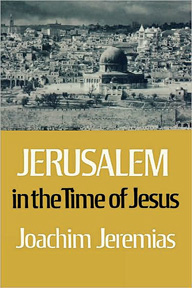Multimedia • Reference • Religion • Travel |
 Jerusalem in the Time of Jesus: An Investigation into Economic & Social Conditions During the New Testament Period Joachim Jeremias
Description From The Publisher: "Where does one look for information on the population of Jerusalem in the time of Jesus? What were the status and condition of slaves both Jewish and Gentile in the first century of the Christian ear? Exactly who were the 'cheif priests' referred to so often in the Gospels and Acts? Answers to these and to hundreds of similar questions related to social and economic conditions during the New Testament period are provivded in this encyclopedic volume by Jeachim Jeremias."
|
|
PART ONE: ECONOMIC CONDITIONS IN THE CITY OF JERUSALEM
I. INDUSTRIES
C. Luxury goods D. The building trade
ii. The building workers: (a) Ordinary building; (b) Skilled craftsmanship in building; (c) Building maintenance
B. The distribution of industries in the city C. The organization of the trades
B. The cultus C. Organization of Temple workers
2. The political and religious significance of the city II. COMMERCE A. Evidence of commerce in Jerusalem
2. Foreign trade 3. Local trade
B. Fruit and vegetables C. Livestock D. Raw materials
2. Political and religious importance of the city III. FOREIGN VISITORS A. Evidence for foreign visitors in the city
B. Accommodation in Jerusalem
B. Rome C. Greece D. Cyprus E. Asia Minor F. Mesopotamia G. Parthia H. Syria I. Arabia J. Egypt K. Cyrene L. Ethiopia B. The unique character of Jerusalem
2. Political and religious importance of the city Excursus The number of pilgrims at Passover Additional Note on calculating the number of festival pilgrims PART TWO: ECONOMIC STATUS IV THE RICH A. The court B. The wealthy class
2. Representatives of the wealthy class V THE MIDDLE CLASS VI THE POOR A. Slaves and day laborers B. The subsidized sections of the population VII. DECISIVE FACTORS IN DETERMINING THE ECONOMIC CIRCUMSTANCES OF THE PEOPLE OF JERUSALEM A. Economic and geographic situation of the city
2. The cost of living in times of emergency B. The political situation
2. War and spoliation C. Religion and cultus
2. Pilgrim traffic 3. Income from the Cultus
Excursus II Disasters in Jerusalem PART THREE: SOCIAL STATUS VIII THE CLERGY
B. The chief priests and chief Levites C. The priestly aristocracy
D. The 'ordinary' priests E. The Levites F. The hereditary character of the priesthood IX THE LAY NOBILITY X THE SCRIBES XI THE PHARISEES PART FOUR: THE MAINTENANCE OF RACIAL PURITY XII THE STRUCTURE OF THE NATIONAL COMMUNITY XIII ISRAELITES OF PURE ANCESTRY A. Legitimacy of ancestry B. Historical value of lay genealogies C. Civil rights of full Israelites XIV DESPISED TRADES AND JEWISH SLAVES A. Despised trades B. Jewish slaves XV ILLEGITIMATE ISRAELITES A. Israelites with slight blemish
2. Proselytes 3. Freed Gentile slaves B. Israelites with grave blemish
2. Temple slaves, fatherless, foundlings, eunuchs XVI GENTILE SLAVES XVII THE SAMARITANS XVIII THE SOCIAL POSITION OF WOMEN List of High Priests Jerusalem Scribes Index of Names and Subjects Index of References |
Customer Reviews
Write your own online review.
Look for Similar Books by Subject
 Jerusalem: One City, Three Faiths
Jerusalem: One City, Three Faiths
Copyright ©1996-2011 CenturyOne Bookstore. All Rights Reserved.
All prices subject to change and given in U.S. dollars.
Your purchase from CenturyOne.com will assist the CenturyOne Foundation in providing funding for various archaeological and research projects which seek to provide more information about the period of the First Century C.E., the origins of Christianity and the world of the Bible in general.
All materials contained in http://www.centuryone.com are protected by copyright and trademark laws and may not be used for any purpose whatsoever other than private, non-commercial viewing purposes. Derivative works and other unauthorized copying or use of stills, video footage, text or graphics is expressly prohibited.

